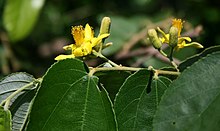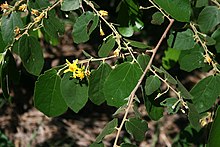| Grewia hexamita | |
|---|---|

| |
| Close-up of flowers | |

| |
| View of foliage | |
| Conservation status | |
 Least Concern (IUCN 3.1) | |
| Scientific classification | |
| Kingdom: | Plantae |
| Clade: | Tracheophytes |
| Clade: | Angiosperms |
| Clade: | Eudicots |
| Clade: | Rosids |
| Order: | Malvales |
| Family: | Malvaceae |
| Genus: | Grewia |
| Species: | G. hexamita |
| Binomial name | |
| Grewia hexamita Burret | |
| Synonyms | |
| |
Grewia hexamita, the giant raisin, is a species of flowering plant in the family Malvaceae, native to Mozambique and adjoining countries. It is a large tree for a Grewia, reaching 5 m (16 ft). It is the most preferred woody plant of African savanna elephants (Loxodonta africana), who browse on it in all seasons, unlike even other species of Grewia.
References
- Botanic Gardens Conservation International (BGCI).; IUCN SSC Global Tree Specialist Group (2020). "Grewia hexamita". IUCN Red List of Threatened Species. 2020: e.T146455855A146455857. doi:10.2305/IUCN.UK.2020-2.RLTS.T146455855A146455857.en. Retrieved 18 November 2021.
- ^ "Grewia hexamita Burret". Plants of the World Online. Board of Trustees of the Royal Botanic Gardens, Kew. Retrieved 1 June 2021.
- Mothogoane, M.S. (August 2012). "Grewia hexamita Burret". Plants of the Week. South Africa National Biodiversity Institute. Retrieved 1 June 2021.
SA Tree No: 460
- Viljoen, J. J.; Reynecke, H. C.; Panagos, M. D.; Langbauer, W. R.; Ganswindt, A. (2013). "Seasonal Selection Preferences for Woody Plants by Breeding Herds of African Elephants (Loxodonta africana) in a Woodland Savanna". International Journal of Ecology. 2013: 1–10. doi:10.1155/2013/769587. hdl:2263/39625.
| Taxon identifiers | |
|---|---|
| Grewia hexamita |
|
This Grewioideae article is a stub. You can help Misplaced Pages by expanding it. |